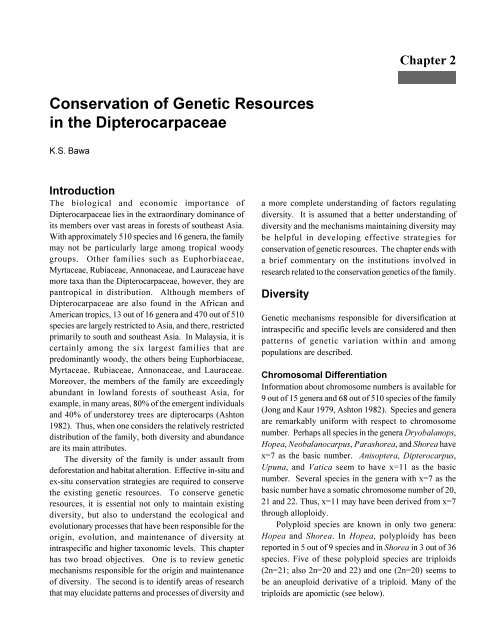A review of dipterocarps - Center for International Forestry Research
A review of dipterocarps - Center for International Forestry Research
A review of dipterocarps - Center for International Forestry Research
You also want an ePaper? Increase the reach of your titles
YUMPU automatically turns print PDFs into web optimized ePapers that Google loves.
Conservation <strong>of</strong> Genetic Resources<br />
in the Dipterocarpaceae<br />
K.S. Bawa<br />
Introduction<br />
The biological and economic importance <strong>of</strong><br />
Dipterocarpaceae lies in the extraordinary dominance <strong>of</strong><br />
its members over vast areas in <strong>for</strong>ests <strong>of</strong> southeast Asia.<br />
With approximately 510 species and 16 genera, the family<br />
may not be particularly large among tropical woody<br />
groups. Other families such as Euphorbiaceae,<br />
Myrtaceae, Rubiaceae, Annonaceae, and Lauraceae have<br />
more taxa than the Dipterocarpaceae, however, they are<br />
pantropical in distribution. Although members <strong>of</strong><br />
Dipterocarpaceae are also found in the African and<br />
American tropics, 13 out <strong>of</strong> 16 genera and 470 out <strong>of</strong> 510<br />
species are largely restricted to Asia, and there, restricted<br />
primarily to south and southeast Asia. In Malaysia, it is<br />
certainly among the six largest families that are<br />
predominantly woody, the others being Euphorbiaceae,<br />
Myrtaceae, Rubiaceae, Annonaceae, and Lauraceae.<br />
Moreover, the members <strong>of</strong> the family are exceedingly<br />
abundant in lowland <strong>for</strong>ests <strong>of</strong> southeast Asia, <strong>for</strong><br />
example, in many areas, 80% <strong>of</strong> the emergent individuals<br />
and 40% <strong>of</strong> understorey trees are <strong>dipterocarps</strong> (Ashton<br />
1982). Thus, when one considers the relatively restricted<br />
distribution <strong>of</strong> the family, both diversity and abundance<br />
are its main attributes.<br />
The diversity <strong>of</strong> the family is under assault from<br />
de<strong>for</strong>estation and habitat alteration. Effective in-situ and<br />
ex-situ conservation strategies are required to conserve<br />
the existing genetic resources. To conserve genetic<br />
resources, it is essential not only to maintain existing<br />
diversity, but also to understand the ecological and<br />
evolutionary processes that have been responsible <strong>for</strong> the<br />
origin, evolution, and maintenance <strong>of</strong> diversity at<br />
intraspecific and higher taxonomic levels. This chapter<br />
has two broad objectives. One is to <strong>review</strong> genetic<br />
mechanisms responsible <strong>for</strong> the origin and maintenance<br />
<strong>of</strong> diversity. The second is to identify areas <strong>of</strong> research<br />
that may elucidate patterns and processes <strong>of</strong> diversity and<br />
Chapter 2<br />
a more complete understanding <strong>of</strong> factors regulating<br />
diversity. It is assumed that a better understanding <strong>of</strong><br />
diversity and the mechanisms maintaining diversity may<br />
be helpful in developing effective strategies <strong>for</strong><br />
conservation <strong>of</strong> genetic resources. The chapter ends with<br />
a brief commentary on the institutions involved in<br />
research related to the conservation genetics <strong>of</strong> the family.<br />
Diversity<br />
Genetic mechanisms responsible <strong>for</strong> diversification at<br />
intraspecific and specific levels are considered and then<br />
patterns <strong>of</strong> genetic variation within and among<br />
populations are described.<br />
Chromosomal Differentiation<br />
In<strong>for</strong>mation about chromosome numbers is available <strong>for</strong><br />
9 out <strong>of</strong> 15 genera and 68 out <strong>of</strong> 510 species <strong>of</strong> the family<br />
(Jong and Kaur 1979, Ashton 1982). Species and genera<br />
are remarkably uni<strong>for</strong>m with respect to chromosome<br />
number. Perhaps all species in the genera Dryobalanops,<br />
Hopea, Neobalanocarpus, Parashorea, and Shorea have<br />
x=7 as the basic number. Anisoptera, Dipterocarpus,<br />
Upuna, and Vatica seem to have x=11 as the basic<br />
number. Several species in the genera with x=7 as the<br />
basic number have a somatic chromosome number <strong>of</strong> 20,<br />
21 and 22. Thus, x=11 may have been derived from x=7<br />
through alloploidy.<br />
Polyploid species are known in only two genera:<br />
Hopea and Shorea. In Hopea, polyploidy has been<br />
reported in 5 out <strong>of</strong> 9 species and in Shorea in 3 out <strong>of</strong> 36<br />
species. Five <strong>of</strong> these polyploid species are triploids<br />
(2n=21; also 2n=20 and 22) and one (2n=20) seems to<br />
be an aneuploid derivative <strong>of</strong> a triploid. Many <strong>of</strong> the<br />
triploids are apomictic (see below).

















